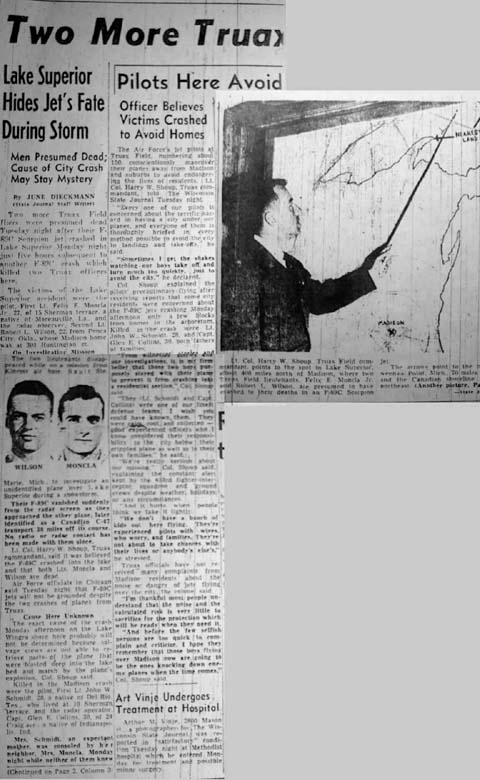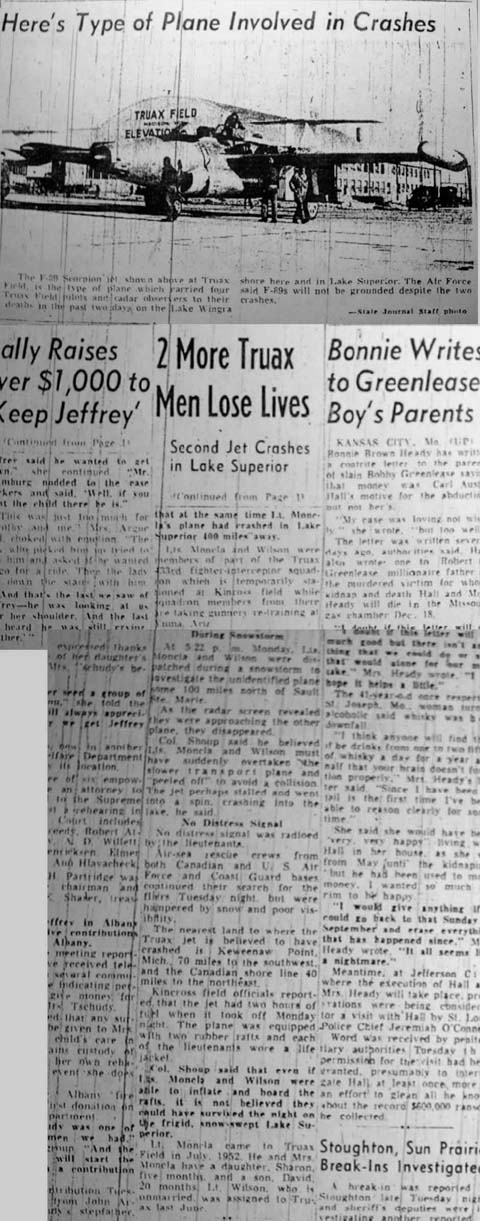Lake Superior Hides Jet's Fate During Storm
Men Presumed Dead; Cause of City Crash May Stay Mystery

By June Dieckmann
(State Journal Staff Writer)
Two more Truax Field fliers were presumed dead Tuesday night after their F-8C Scorpion Jet crashed in Lake Superior Monday night just five hours subsequent to another F-89C crash which killed two Truax officers here.
The victims of the Lake Superior accident were the pilot, First Lt. Felix E. Moncla Jr., 27, of 15 Sherman Terrace, a native of Moreauville, La., and the radar observer, Second Lt. Robert L. Wilson, 22, from Ponca City, Okla., whose Madison home was 301 Huntington Ct.
On Investigating Mission
The two lieutenants disappeared while on a mission from Kinross air base Sault Ste. Marie, Mich., to investigate an unidentified plane over Lake Superior during a snowstorm.
Their F-89C vanished suddenly from the radar screen as they approached the other plane, later identified as a Canadian C-47 transport 30 miles off its course. No radio or radar contact has been made with them ever since.
Lt. Col. Harry W. Shoup, Truax commandant, said it was believed the F-89C crashed into the lake and both Lts. Moncla and Wilson are dead.
Air Force officials in Chicago said Tuesday night that F-89C jets will not be grounded despite the two crashes of planes from Truax.
Cause Here Unknown

The exact cause of the crash Monday afternoon on the Lake Wingra shore here probably will not be determined because salvage crews were not able to retrieve parts of the plane that were blasted deep into the lake bed and marsh by the plane's explosion, Col. Shoup said.
Killed in the Madison crash were the pilot, First Lt. John W. Schmidt, 28, a native of Del Rio, Tex., who lived at 10 Sherman Terrace, and the radar operator, Capt. Glen E. Collins, 30, of 24 Craig Ave. a native of Indianapolis, Ind.
Mrs. Schmidt, an expectant mother was consoled by her neighbor, Mrs. Moncla, Monday night while neither of them knew that at the same time Lt. Moncla's plane had crashed in Lake Superior, 400 miles away.
Lts. Moncla and Wilson were members of part of the Truax 433rd fighter-interceptor squadron which is temporarily stationed at Kinross field while squadron members from there are taking gunnery re-training at Yuma, Ariz.
During Snowstorm
At 5:22 pm Monday, Lts. Moncla and Wilson were dispatched during a snowstorm to investigate the unidentified plane some 100 miles north of Sault Ste. Marie.
As the radar screen revealed they were approaching the other plane, they disappeared.
Col. Shoup said he believed Lts. Moncla and Wilson must have suddenly overtaken the slower transport plane and "peeled off" to avoid a collision. The jet perhaps stalled and went into a spin, crashing into the lake, he said.
No Distress Signal
No distress signal was radioed by the lieutenants.
Air-sea rescue crews from Canadian and U.S. Air Force and Coast Guard bases continued their searches for the fliers Tuesday night, but were hampered by snow and poor visibility.
The nearest land to where the Truax jet is believed to have crashed is Keweenaw Point, Mich., 70 miles to the southwest, and the Canadian shore line which is 40 miles to the northeast.
Kinross field officials reported that the jet had two hours of fuel when it took off Monday night. The plane was equipped with two rubber rafts and each of the lieutentants wore a life jacket.
Col. Shoup said that even if Lts. Moncla and Wilson were able to inflate and board the rafts, it is not believed they could have survived the night on the frigid, snow-swept Lake Superior.
Lt. Moncla came to Truax field in July, 1952. He and Mrs. Moncla have a daughter, Sharon, five months, and a son, David, 20 months. Lt. Wilson, who is unmarried was assigned to Truax last June.